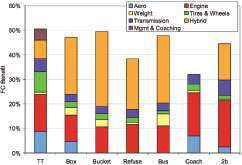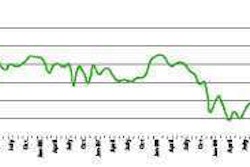Industry applauds presidential fuel economy, emissions memorandum
American Trucking Associations leaders commended President Obama’s memorandum directing the U.S. Department of Transportation and the Environmental Protection Agency to develop national standards for fuel economy and greenhouse gas emissions for heavy- and medium-duty trucks (see “Obama orders heavy truck fuel economy standards,” page 16), an act that effectively endorses the ATA Sustainability Task Force recommendation in 2008 that called for national fuel economy standards for trucks to reduce greenhouse gas emissions.
 Comparison of 2015-2020 new vehicle potential fuel savings technology for seven vehicle types: tractor-trailer (TT), Class 3-6 box (Box), Class 3-6 bucket (Bucket), Class 8 refuse (Refuse), transit bus (Bus), motorcoach (Coach) and Class 2b pickups and vans (2b).
Comparison of 2015-2020 new vehicle potential fuel savings technology for seven vehicle types: tractor-trailer (TT), Class 3-6 box (Box), Class 3-6 bucket (Bucket), Class 8 refuse (Refuse), transit bus (Bus), motorcoach (Coach) and Class 2b pickups and vans (2b).ATA’s Sustainability Task Force was established in 2007 to be the industry voice on the issue when EPA would begin to regulate truck fuel economy. “President Obama told us that this could be a model of industry and government cooperation in developing beneficial regulations,” ATA Chairman Tommy Hodges said after the signing ceremony on May 21.
EPA Administrator Lisa Jackson acknowledged that the trucking industry has made huge advances in reducing the emissions of particulate matter, nitrogen oxides and sulfur oxides from trucks.
“Unfortunately, some advances have come at the cost of a reduction in fuel economy and a slight increase in carbon dioxide output,” says Hodges. “Now we have the opportunity to fix that and substantially increase our fuel economy.” ATA says it will continue to work with government agencies to develop beneficial, attainable, affordable and cost-efficient standards.
In the release of its sustainability plan two years ago, ATA announced its support of technologically feasible national fuel economy standards for medium- and heavy-duty trucks that reduce fuel consumption. Other components of the plan include:
• Federal laws requiring trucks to have speed governors set at 65 mph or below, and a national speed limit of 65 mph for all vehicles;
• Allowing more productive truck weights and combinations;
• Expansion of the EPA SmartWay Transportation program, which works to reduce greenhouse gases and save fuel;
• Reducing idling by updating the interstate system and reducing traffic congestion; and
• Using new technologies to reduce other engine idling.
Visit www.trucksdeliver.org for more information about ATA’s sustainability plan. n













